| |
- "Frank Lloyd Wright: His Life and His Architecture"
by Robert C. Twombly, published by Wiley-IEEE, 1987
http://books.google.at/
1 a » A Home in a Prairie Town « Page 53 shows a reproduction […] of the February 1901 article in "The Ladies' Home Journal" [http://www.steinerag.com/ 2].
» A Small House with 'Lots of Room in It' « [… 2 3] was also published in The Ladies' Home Journal July 1901. [http://www.steinerag.com/ 2 3]
» After explaining the plans and specifying the costs - $7000 for the 'Prairie' and $5800 for the 'Small' House - Wright declared himself ready to accept orders. « [page 52] See also: XII.) 20
Details according to Twombly [page 56, note 14]
11 [page 224]
8 Key to plan [page 225, 226, 227] See also II.) Img. _04
Here [page 226] Wright's project is labelled » "Non-Competitive Plan" (1913) for the National Conference on City Planning « VII.) VIII.)
- ^ a b c '[Publications of The City Club of Chicago] City Residential Land Development:
Studies in Planning: Competitive Plans for Subdividing a Typical Quarter Section of Land in the
Outskirts of Chicago', edited by Alfred B. [Beaver] Yeomans [Landscape Architect], published by The University of Chicago Press, December 1916
PDF from http://www.archive.org/
» Program of a Competition
with Cash Prizes
for the procuring of a
Scheme of Development
for a Quarter-Section of Land
within the Limits of the
City of Chicago, Illinois
[…]
For good reasons it has been detemined that the area for the laying out
of which plans are to be submitted in this competition shall be, not a precisely
located, but an imaginary or an assumed site, as follows: « [page 1, 2]
Wilhelm Bernhard was awarded first prize, Arthur C. Comey
second, Albert and
Mrs. Ingrid Lilienberg third.
43 plans were submitted, 39 reported by the jury, 33 [including Wright's] published.
Illustrations of "NON-COMPETITIVE PLAN" or "PLAN BY FRANK LLOYD WRIGHT" for "CITY RESIDENTIAL LAND DEVELOPMENT" [Chicago City Club Competition 1913]
Img. _08 Bird's-Eye View of the Quarter-Section [page 97]
Img. _04 [Site] Plan including "KEY TO PLAN" and "STATISTICAL DATA" [page 98]
Img. _05 Quadruple Block Scheme C [page 100]
Img. _02_a not labelled, depicting a 'Prairie House' [probably 0007.001 XV.) Img. _02 page 101]
Img. _07 Standard City Block as used for computations [page 138]
5 a » […] A succession of buildings of any given length by this arrangement presents the aspect of well-grouped buildings in a park, of greater picturesque variety than is possible where façade follows façade. « [Frank Lloyd Wright] (page 99)
See also IV.) 9
6 » EXPLANATION OF ALTERNATIVE BLOCK ARRANGEMENTS
A. Quadruple re-subdivision of city block by means of single
cross street and parterres into four sub-blocks. Four houses
grouped at center of each sub-block about an interior court
enclosed by low walls — 1/4 of the enclosure available to each
of the four houses.
One entrance to one house only on each side of each sub-block.
No alleys — houses revolving in plan so that living-rooms and verandas face outward and kitchens inward to
courts. A single plan used thus is always presented at a
different angle in harmonious groups of four.
B. Same. Single cross street — no parterres. Houses grouping
across the streets increasing interior court gardens and giving
direct access from street to all houses without parterres. […] « [page 101]
- 'Modern Architecture: Being the Kahn Lectures for 1930'
by Frank Lloyd Wright [published first 1931] with a new introduction by Neil Levine, published by Princeton University Press, 2008 http://books.google.at/
4 a » […] The 1912-13 project for a thirty-two-block residential area of Chicago done in the context of the Chicago City Club Competition for a Model Quarter-Section was designed in response to a request from the club's civic secretary, George Hooker, and is in no way an ideal, comprehensive city plan. « XII.) 23
[Neil Levine, note 178, page lxix]
- ^ "Shaping the City: Studies in History, Theory and Urban Design"
by Rodolphe El-Khoury, Edward Robbins, published by Routledge, 2004
3 » [… because] Wright did not participate in competitions. « Note 12, page 75 accredits that information to Neil Levine. XII.) 23
http://books.google.at/
14 [page 60] reproduction of Hoyt's diagram V.) 13 » Various methods of subdividing a 40 Acre Tract, 1320 Feet Square « [page 431, figure 103, type E]
9 a [page 61]
http://books.google.at/
- "One Hundred Years of Land Values in Chicago: The Relationship of the Growth of Chicago to the Rise of Its Land Values, 1830-1933"
by Homer Hoyt, Harry A. Millis, published by Beard Books, 2000 [published first in 1933]
16 [page 429]
13 » Various methods of subdividing a 40 Acre Tract, 1320 Feet Square « [page 431, figure 103, type E]
http://books.google.at/
Details according to El-Khoury and Robbins IV.) 14
- ^ 'FRANK LLOYD WRIGHT: DIE LEBENDIGE STADT' edited by David G. De Long, published by Vitra Design Museum, Weil am Rhein / Skira editore, Milan, 1998
http://books.google.at/ (German)
Img. _02 Caption: » "Eln Haus in einer Präriestadt" für das Ladies' Home Journal, 1900 (Projekt) « [House in a Prairie City] by Frank Lloyd Wright [page 182]
Img. _03 Caption: » Viererblockplan, 1900-1903 (Projekt) « [Quadruple Block Plan] by Frank Lloyd Wright [page 248]
- a b 'The Birth of City Planning in the United States, 1840-1917' by Jon A. Peterson, JHU Press, 2003
» […]
in 1912-1913 both the NCCP [National Conference on City Planning VIII.)] and the Chicago City Club had sponsored model-suburb design contests. The planners did so as a conference study-project, the City Club II.) as an open competition with prizes. «
http://books.google.at/
[page 282]
- a b c The First National Conference on City Planning was held in Washington, D.C. in May 1909
PDF from http://www.archive.org/
The fifth conference took place in Chicago in May 1913
PDF from http://www.archive.org/
» While the goal
of our so-called city planning movement is the actual improvement
of cities, the translation of plans into facts,
[…] one of the big steps toward
that goal is the substitution of plans for mere talk about
plans or about the subjects with which plans deal. […] «
[page 168]
… making very general comments on 9 presented 'city planning studies' (page 93 onwards, list of participants page 210) and only one [!] reference to the City Club competition:
» We have also carried
out, as some of you saw yesterday at the City Club, a study
of a particular quarter section of a level city from a
theoretical standpoint. « [page 189]
7
The Seventh National Conference on City Planning [Detroit June 1915] provides a brief history of Chicago block sizes.
http://www.archive.org/ [page 244 onwards]
- 'The Architecture of Frank Lloyd Wright' by Neil Levine, published by Princeton University Press, 1996 http://www.books-by-isbn.com/
Img. _01 'Quadruple Block Plan' by Frank Lloyd Wright
published in 'The Ladies' Home Journal' [http://www.steinerag.com/] February 1901
Caption: » "Quadruple Block Plan" project, 1900. Perspective and plan. « [page 31]
Note 20, page 440 » The plans were commissioned by Edward Bok, president of the Curtis Publishing Company. The "Quadruple Block Plan" appeared in the February 1901 Ladies' Home Journal. Wright reworked it as the basis for a twenty-four-unit development for Charles E. Roberts, for Oak Park, in 1900-1903. «
- 17 The competition program was issued in 1912; competition deadline was March 3, 1913; an exhibition at the club building was due to open March 7, 1913 II.) also displaying Wright's project. XII.) 23
19 a Img. _06
Block sizes of 270 x 600 feet - based on graphic approximation to the site plan Img. _04 and competition guidelines - are [strictly speaking] speculative as are relating / resulting lot dimensions of approx. 64 x 60 feet [approx. 360 square meters]. Nevertheless: the site plan does indicate lots nearly half the size of the Roberts scheme. Img. _10 Thus houses with gross floor areas of let's say ~170 m 2 at ground level would leave 6 m of open space between them, houses with ~121 m 2 would have 8 m distance … a hypothetic 1:1 ratio of solids and intervals limits constructed areas to ~90 m 2.
With "Two-flat Buildings" [evidently larger, labelled "W" bottom left in Img. _04] consuming almost their entire lot, again "façade would follow façade" II.) 5 …
- 'The Living City' by Frank Lloyd Wright, published by Horizon Press, 1958
Img. _09 [page 150]
18 Apartments … [page 171]
- IN: 'Frank Lloyd Wright: From Within Outward' published on the occasion of the exhibition 'Frank Lloyd Wright: From Within Outward' at the Guggenheim Museum NY 2009, by Skira Rizzoli Publications Inc. 2009
http://www.books-by-isbn.com/
'Making Community Out of the Grid: WRIGHT'S QUADRUPLE BLOCK PLAN AND THE ORIGIN OF THE PRAIRIE HOUSE' by Neil Levine [page 58 to 73]
20 a b » The Quadruple Block Plan and the Ladies' Home Journal, "A Home in a Prairie Town," 1900-01 «
Page 65 shows also I.) 1 a reproduction […] of the February 1901 article published in ' The Ladies' Home Journal' [for an even larger reprint see XV.) ] http://www.steinerag.com/ 2
» A Home in a Prairie Town
By FRANK LLOYD WRIGHT
This is the Fifth Design in the Journal's New Series of Model Suburban Houses Which Can be Built at Moderate Cost «
» […] Cement on metal lath is suggested for the exterior covering throughout, because it is simple, and, as now understood, durable and cheap. The cost of this house with interior as specified and cement construction would be seven thousand dollars: […]
Total … $6970 « [text by Frank Lloyd Wright]
[ensued by an] » EDITOR'S NOTE - As a guarantee that the plan of this house is practicable, and that the estimates for cost are conservative, the architect is ready to accept the commission of preparing the working plans and specifications for this house to cost Seven Thousand Dollars […] «
21 a All figures according to Neil Levine pages 66, 67, 68, who also gives a detailed account of the actual geometries developed for the Roberts project(s). Img. _03
» First Roberts Master Plan, 1896 « XV.)
possibly: » New Idea for Suburbs … 1901 «
and » Adaptation of the Quadruple Block Plan to the Roberts Block, 1903 «
22 [page 68]
Wright replaced standard "multipurpose alleys" with pedestrian ways called 'esplanades' and vehicular passages called 'courts'. He also had a version for the Roberts project Img. _03 drawn » with the lots squared up as much as possible « [page 70], thus » increasing the length of the block (to the inside of the sidewalks) from 465 to 558 feet. « [page 73, note 21]
23 a b c Page 73; Note 26 resolves the procedures regarding the Chicago City Club Housing Competition.
26 caption for FLLW FDN # 0309.003 [page 71] Img. _10
- 'You Dear Old Prima Donna: The Letters
of Frank Lloyd Wright and Jens Jensen' by Virginia L. Russell, FASLA, published in Landscape Journal 2001; 20:2; PDF [pages 141-155]
24 » […] In 1913, the Chicago City Club,
when Jensen was their Chair of City Planning,
held a competition for the design of a suburban
community, and Wright did not enter his
design, which evolved into the Broadacre City,
in the competition, instead choosing to submit
the scheme "hors concours," as one reviewer
put it, or "outside the competition." Jensen
was on the jury for the competition, and it
would be a dispute over Broadacre City that ultimately
ended their friendship thirty years
later. […] « [page 154, note 8]
- IN: 'Center: A Journal of Architecture in America', 'Modernist Visions and the Contemporary American City' - Volume 5, published in 1989 by the Center of the Study of American Architecture, School of Architecture, The University of Texas at Austin. http://soa.utexas.edu/
'Broadacre City: The Reception of a Modernist Vision, 1932-1988' by Anthony Alofsin [pages 8 - 43]
25 [pages 11, 12]
- 'Frank Lloyd Wright 1885-1916: The Complete Works' [Volume 1] by Bruce Brooks Pfeiffer, edited by Peter Gössel, published by Taschen 2011
http://www.taschen.com/
'Housing Project for Charles E. Roberts' 1896 Ridgeland Oak Park Illinois [project page 81]
'Block Plan for Charles E. Roberts' 1897 Oak Park, Illinois [project, page 85]
'A Home in a Prairie Town', 1901, Ladies' Home Journal [project, page 118]
Img. _02 0007.001 coloured version, II.) Img. _02_a very similar, actually not dated but in the context of 'A Home in a Prairie Town' publication of 1901 [page 119]
Img. _01 0007.009 » A Home in a Prairie Town by Frank Lloyd Wright « magazine page reproduction [page 120] as published in 'The Ladies' Home Journal' [http://www.steinerag.com/] February 1901, page 17
"Quadruple Block Plan" 1901 Ladies' Home Journal [project, page 128]
'Charles E. Roberts Block Plan' 1903, Oak Park, Illinois [0309, project, page 204-206]
Img. _10
0309.003 'new block plan' with clearly readable measurements [not labelled, deatail, page 205] See also FLW 0309.006
27 » One scheme shows the houses extremely close to each other on very narrow lots running the length of the property. There are 15 houses each on the lower and upper halves (0309.006), with those on the lower side by Wright and those on the upper side drawn in the Victorian style. It is possible this plan, which is not very appealing, was made to show the client the most conventional but least desirable solution. « [page 206]
Model Quarter Section, City Residential Land Development, 1913, Chicago, Illinois [project, page 460]
28 » […] Wright’s text is long and detailed in explanation for all aspects of the plan, and a careful study of what he wrote at the time reveals his concern for urban planning, a concern that would be further developed when he set to work, in 1934, on the plan and model of Broadacre City, which several elements in this scheme anticipate. For the residential block plan he has taken elements from the Roberts block plan of 1903 (project 0309) and incorporated them into this project as plan A, plan B, and plan C. « [see Img. _05]
- 'Ausgeführte Bauten und Entwürfe von Frank Lloyd Wright [Studies and Executed Buildings by Frank Lloyd Wright]' Reprint of the portfolio edition of 100 lithographs published in 1910 by Verlag Ernst Wasmuth A.G., Berlin, second edition, 1998 http://www.steinerag.com/
For a digital 1910 edition Volume I, Volume II see the University of Utah, J. Willard Marriott Library
Img. _03 [page 20] Label: » TAFEL XIII a RECHTECKIGE HÄUSERBLÖCKE FÜR DIE PRAIRIE-GEMEINSCHAFT.
GEDRUCKT UND VERLEGT VON ERNST WASMUTH A.-G., BERLIN «
http://content.lib.utah.edu/
Img. _02 [page 19] Label: » TAFEL XIII PRAIRIE-HAUS FÜR DIE PRAIRIE-GEMEINSCHAFT.
GEDRUCKT UND VERLEGT VON ERNST WASMUTH A.-G., BERLIN «
http://content.lib.utah.edu/
|

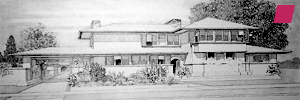
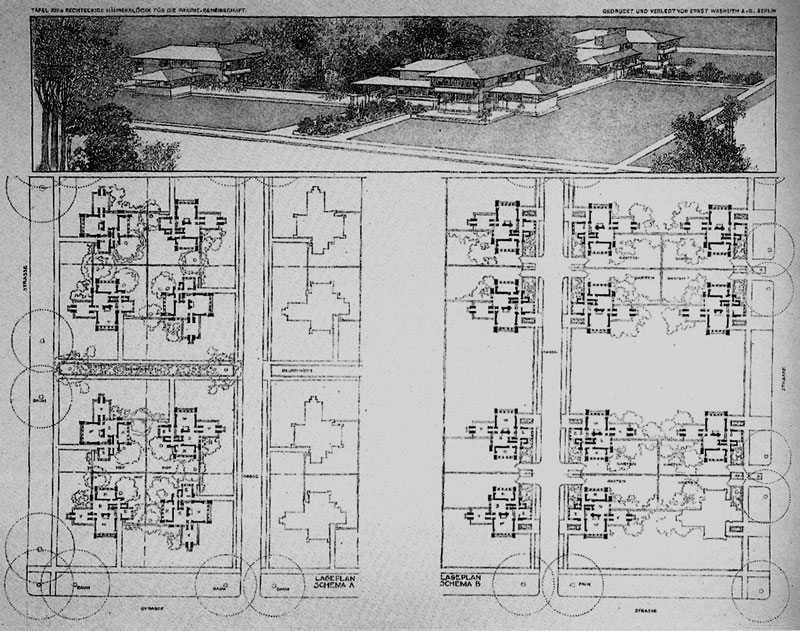
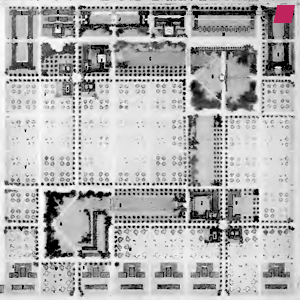
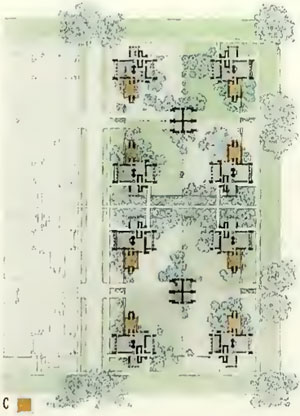
![Chicago block compared to Frank Lloyd Wright's Quadruple Block [Sdoutz 2008] Chicago block compared to Frank Lloyd Wright's Quadruple Block [Sdoutz 2008]](content/chicago_usual_block_diagram_2008.gif)
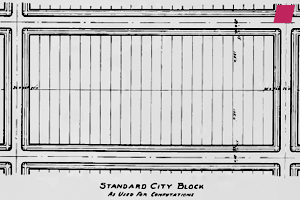
!['Expanded Roberts Block' by Frank Lloyd Wright from 'Frank Lloyd Wright 1885-1916: The Complete Works' [Volume 1] by Bruce Brooks Pfeiffer, edited by Peter Gössel, published by Taschen 2011 'Expanded Roberts Block' by Frank Lloyd Wright from 'Frank Lloyd Wright 1885-1916: The Complete Works' [Volume 1] by Bruce Brooks Pfeiffer, edited by Peter Gössel, published by Taschen 2011](content/expanded_roberts_block_1903.jpg)
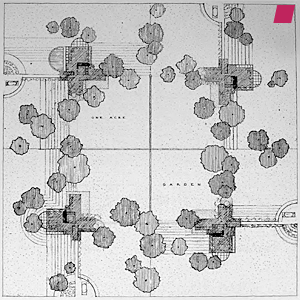






TOP
Social Networks